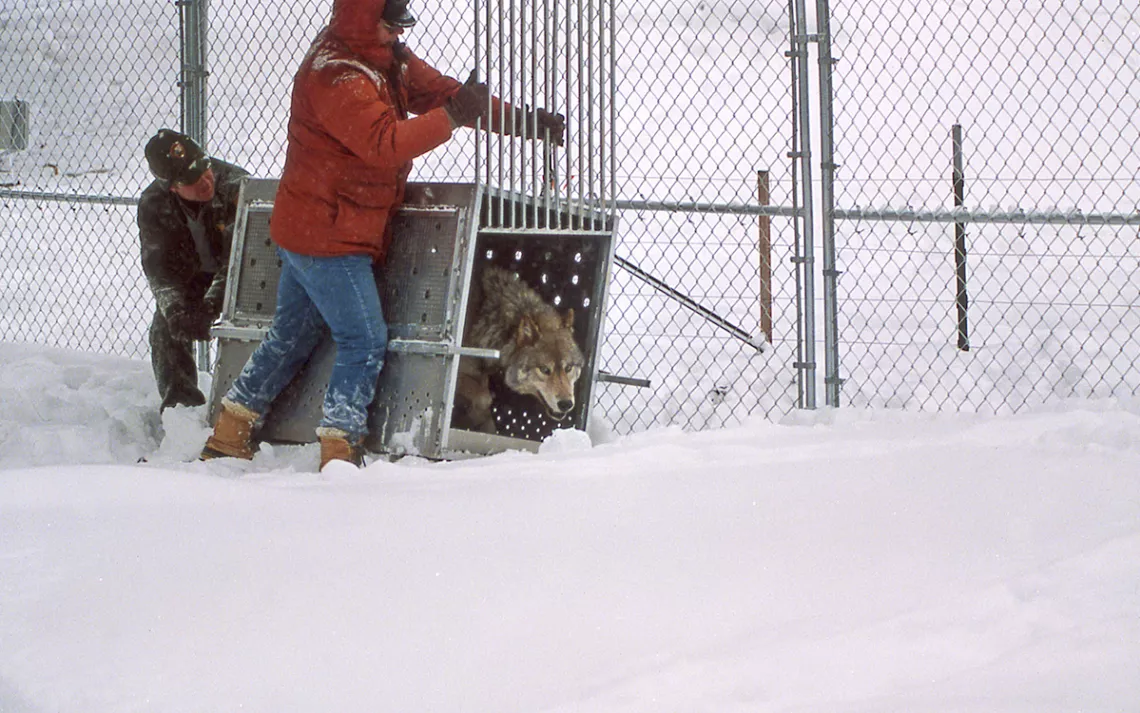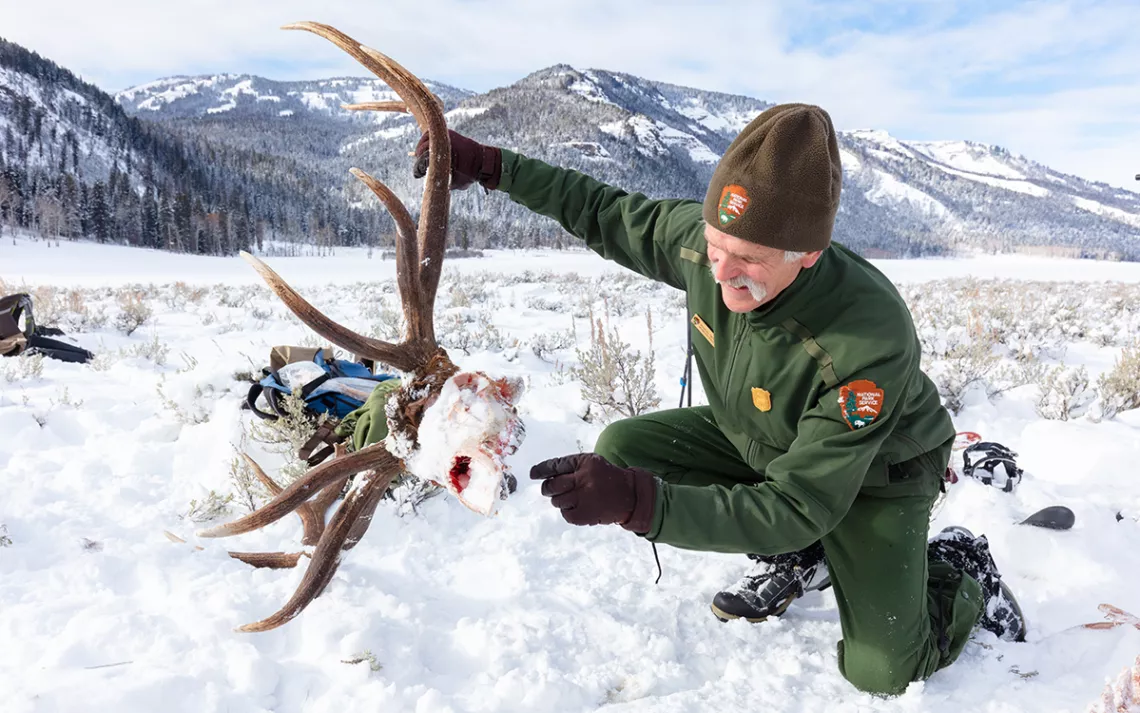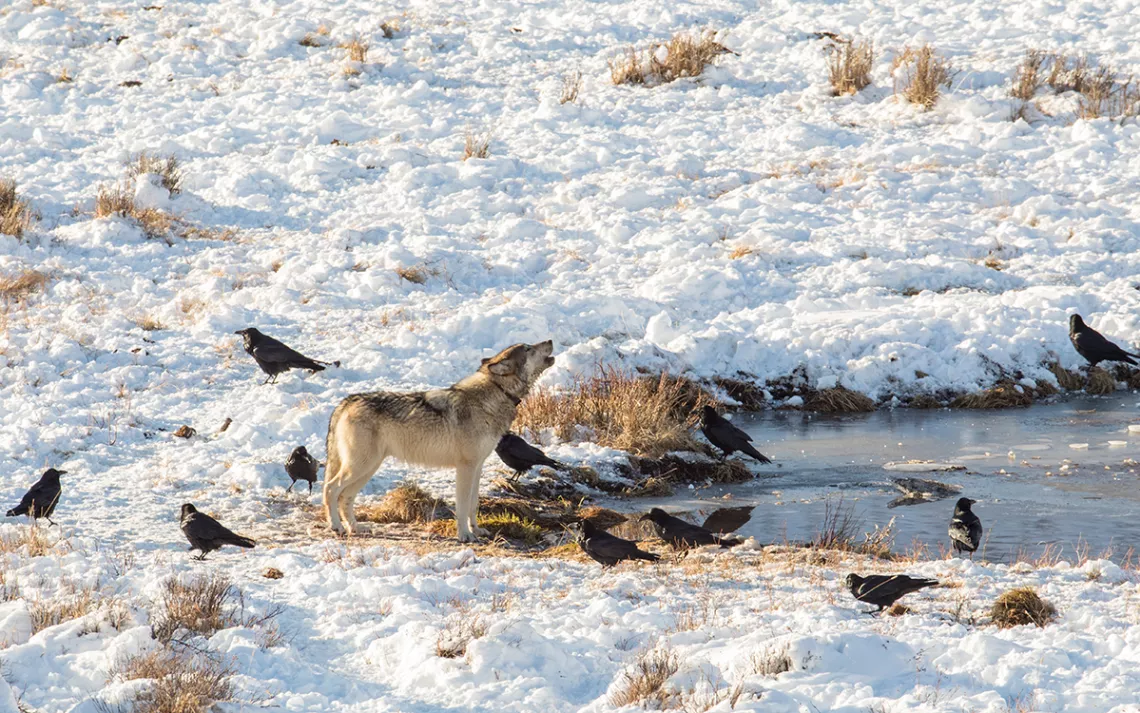In Colorado, Wolves Are on the Ballot
Colorado is the first state to put the carnivore’s fate to a popular vote

Mike Phillips and John Cook release the 38th wolf into Yellowstone National Park in 1995. | Photos courtesy of the National Park Service
A stream slices through the high desert of western Colorado. It swells with clear, cold spring runoff. Willows and aspen necklace the banks, their baby green leaves pointing to the sun. An elk stops to drink, then clambers away at the sound of rustling in the sagebrush.
This is a landscape shaped, in part, by wolves. Right now it’s only a hope for the future, but it could become reality if Coloradans pass Initiative 107, a November ballot measure to reintroduce gray wolves west of the Continental Divide. The measure begins by reminding voters that “historically, wolves were an essential part of the wild habitat of Colorado” and goes on to declare, “Once restored to Colorado, gray wolves will help restore a critical balance in nature.” If Initiative 107 is approved by voters, the Colorado Parks and Wildlife Commission would be charged with designing a plan for reintroduction and management of gray wolves in western Colorado. The commission would then work with the US Fish and Wildlife Service to begin reintroduction by the end of 2023.
Wolf reintroduction is a contentious issue that has swept hunters, ranchers, ecologists, and politicians into long and ugly battles across the West. Conservationists and ecologists argue that reintroducing wolves to western landscapes reestablishes a predator-prey dynamic that has not existed since wolves were systematically eradicated in the 19th and 20th centuries. Ranchers and meat industry associations contend that the predator is dangerous to livestock. Big game advocates say wolves diminish opportunities to hunt deer and elk. The divisions often fall along urban-rural lines: those who recreate on public lands on the weekends versus those who work on public lands, often in livestock grazing. As Christopher Solomon observed in a 2018 feature for The New York Times Magazine, “In bringing back wolves, one side wants to atone for the sins of the past and knit back together a wounded landscape; the other sees in wolves’ proliferation a refutation of the rural way of life of the American West.”
The Colorado initiative marks a plot twist in the decades-long drama over the wolf:
It will be the first time that the reintroduction of wolves anywhere in the United States is decided by popular vote. “Ultimately, people will determine where predators such as wolves can live,” says Rebecca Niemiec, an assistant professor in the Human Dimensions of Natural Resources Department at Colorado State University. She says that research has shown that the effectiveness of many conservation initiatives depends not only on ecological factors but also on social factors, like the public’s attitude toward a species.

Doug Smith, senior wildlife biologist at Yellowstone National Park, examines the skull of an elk killed by a wolf.

A wolf at Blacktail Pond in Yellowstone National Park
Since 41 gray wolves were introduced into the Greater Yellowstone Ecosystem in 1995, the predator has steadily moved out of the Northern Rockies and into western Washington and Oregon as well as the northernmost counties of California. Today, the International Wolf Center estimates that there are 5,500 gray wolves in the continental United States.
Now, the wolves are beginning to recolonize Colorado as well. Last fall, Colorado Parks and Wildlife reported a sighting of six gray wolves, and in January officials found an elk carcass surrounded by canid tracks a few miles from the location of the sighting. Governor Jared Polis was excited. “I am honored to welcome our canine friends back to Colorado after their long absence,” he said at the time.
Polis is not alone in welcoming gray wolves back to the state. A poll conducted by Niemiec and colleagues found that 84 percent of Coloradans support wolf restoration. That’s up from 70 percent, when the last survey was conducted in 1994.
Perhaps more notable is the consistency with which support appears across gender, age, and income levels. Support is also consistent between those who do and do not identify as gun rights advocates, property rights advocates, ranchers, and hunters. Nearly a third of survey respondents expect wolves to impact them positively; 11 percent expect a negative impact.
Several theories might explain these figures. One is that modernization and urbanization have prompted a cultural shift away from a domination view of wildlife and toward a more mutualistic view, as documented by researchers at CSU. “These mutualist values have been associated with greater tolerance for wolves and support for wolf conservation,” Niemiec says. The public might be won over by the science—nearly 20 percent of respondents expecting a positive impact cited ecosystem balance as their reasoning—although the research is hardly conclusive and doesn’t speak to how wolf reintroduction might play out in Colorado specifically. More likely, the overwhelming support for wolf reintroduction is due to a confluence of these factors. Almost 20 percent of respondents expecting a positive impact cited emotional or moral arguments. Essentially: Wolves belong here, and it’s our moral obligation to bring them back.
Proponents of wolf reintroduction in Colorado point to the Yellowstone experience as evidence that restoration not only works but also creates what wildlife ecologists call a “trophic cascade” that redesigns the landscape for the better. Twenty-five years ago, gray wolves were reintroduced to the Greater Yellowstone Ecosystem (GYE), an area of federal land roughly 15 million acres in size, which includes multiple national forests and the 2.2-million-acre Yellowstone National Park.
Mike Phillips was the National Park Service project lead on gray wolf reintroduction in the GYE. An articulate wildlife ecologist whose voice gets louder and more excited when he gets on a roll talking about wolves, Phillips is now the director of the Ted Turner Endangered Species Fund and a Montana state senator. He says that the biggest takeaway from the Yellowstone project is that “wolves helped everyone come to understand, or at least be reminded, that predation really matters, and that restoration is an alternative to extinction.”
Phillips says that some parts of the park look different than they did 25 years ago. Before wolves were reintroduced, elk had the luxury of being careless as they grazed. When the wolves arrived, they killed some elk and kept the rest moving on the landscape, which reduced grazing pressure. Aspen and willow groves have regenerated as a result, and songbirds have returned. Today the streamside vegetation is back, and downstream drinking water is clearer, according to National Geographic. The grizzly bear population has rebounded, likely as a result of an increase in carcasses left by wolves.
Not everyone agrees with this telling of the story. Arthur Middleton, an assistant professor of environmental science, policy, and management at UC Berkeley who has studied wolves near Yellowstone, wrote a New York Times op-ed in 2014 arguing that the trophic cascade in Yellowstone is a myth. While preliminary observations suggested aspen and willow might be rebounding, follow-up studies haven’t corroborated this finding. “Perhaps the greatest risk of this story is a loss of credibility for the scientists and environmental groups who tell it,” he writes.
Some say wolves have also helped mitigate climate change in the GYE. “In an arid West, where climate change is taking a real toll on streams, the restoration of vegetation is critical to storing water,” says Delia Malone, a volunteer leader with the Sierra Club’s Colorado Chapter and an ecologist and outreach coordinator for the Rocky Mountain Wolf Project, the main group advocating for wolf restoration in Colorado. Vegetation stores carbon, as does intact soil, and Malone says restoring wolves to Colorado would reduce the overgrazing that has turned these resources into carbon emitters instead of the carbon sinks they once were.
Phillips says western Colorado is better suited for gray wolves than anywhere else in the continental US for a couple of reasons: Western Colorado’s 17 million acres of federal public lands are big enough to accommodate wolves, which require large swaths of territory; and there is sufficient prey, to the tune of 700,000 deer and elk. Plus, Colorado would provide the missing link between northern and southern wolf populations, which is important for reducing genetic isolation. “There really could be nothing more important than that in the big picture,” Malone says.
But Colorado isn’t Yellowstone. “Yellowstone casts a very, very big shadow. I would have you believe Yellowstone is the greatest conservation theater in the world,” Phillips says. The grandeur and emotional draw of America’s first national park, along with its specific ecological conditions, made it the perfect testing ground for wolf restoration. Some scientists caution that if wolves are reintroduced in Colorado, in 25 years it may not look like Yellowstone does today. “I would say that anybody [who has] studied these kinds of interactions would not be expecting that there would be a so-called trophic cascade in western Colorado,” says Joanna Lambert, a professor studying animal ecology at CU Boulder and a scientific adviser for the Rocky Mountain Wolf Project. “That’s too neat and tidy a story, and there’s just a lot more going on.”
Jesse Alston, a PhD candidate in ecology at the University of Wyoming, says it’s hard to predict exactly what impact wolves might have on the western Colorado ecosystem. He was the lead author on a 2019 paper examining the ecological impacts of reintroducing native apex predators. The results were inconclusive: Mesopredators (like foxes and coyotes) seemed responsive to the restoration of an apex predator, but the impact got muddled further along the food web. Also, Alston says, “We kind of know from other wolf reintroduction events that people are pretty important players” who can influence the wolf population through hunting or poaching.
That uncertainty isn’t stopping the Rocky Mountain Wolf Project and its sister organization the Rocky Mountain Wolf Action Fund, which gathered the 211,063 signatures required to get wolf restoration on the ballot in November. Founder Rob Edward and volunteers like Malone have been fighting to reintroduce wolves to Colorado since the 1990s, and they are now accelerating their advocacy and public education as the election approaches. Malone has planned screenings of wolf films across the state followed by panel discussions with ecologists, hunters, and ranchers. She says outreach like this has been “instrumental” in informing the public’s attitude toward wolf restoration.
Opponents say the ballot initiative is an irresponsible way to make decisions that could significantly alter the state’s ecosystems and its residents’ way of life. Terry Frankhauser, the executive vice president of the Colorado Cattlemen’s Association, told The Guardian, “We should not be making biological decisions at the ballot box. And to arbitrarily decide, through a population vote, that we need x amount of wolves in Colorado without considering that ecosystem, it’s not only irresponsible to the ranching community, but to the wolves themselves.” (The Colorado Cattlemen’s Association declined to comment for this story.)
Ranchers are concerned that wolves will prey on cattle and sheep, despite analysis of USDA data (conducted on behalf of the Rocky Mountain Wolf Project) that shows wolves predate on just 0.007 percent of cattle that they share territory with across the Northern Rocky Mountains. To address this concern, Initiative 107 would compensate ranchers for verified livestock losses caused by wolves.
The CSU poll suggests that the opposition is a small minority. But it appears to be well organized, especially in rural areas of the state. One group, the Stop the Wolf Coalition, has garnered support from 38 of Colorado’s 64 county commissions. The coalition’s website displays graphic images of pets and livestock killed by wolves.
If livestock carcasses and mauled dogs aren’t enough to shock voters about the danger of wolves, the human impact might. A common refrain of the opposition is that wolves might attack humans. But there’s no evidence to support such scare tactics. According to the International Wolf Center, “A person in wolf country has a greater chance of being killed by a dog, lightning, a bee sting, or a car collision with a deer than being injured by a wolf.” In the 25 years since wolves have called Yellowstone home, not a single human has been hurt or killed by a wolf. (The Stop the Wolf Coalition did not respond to multiple requests for comment.)
Rob Edward of the Rocky Mountain Wolf Action Fund says funding is the biggest hurdle between now and November. He’s hoping support will flow in from across the country. “Even though it’s a Colorado vote, it’s of national significance,” he says, since the area in question is federally managed. “People in Brooklyn, or Oklahoma City, or San Francisco should have the same interest in seeing this succeed.”
If history is any indication, some ranchers and other rural residents might be angered by the notion that folks in population centers like Denver and Boulder (let alone Brooklyn and San Francisco) should have a say in returning wolves to western Colorado. One man writing in the Montrose Daily Press in October likened wolf reintroduction to urbanites letting 50 serial killers loose in a community that isn’t their own. But the management of federal public lands has always been contested. A February report on federal land ownership by the Congressional Research Service observes, “From the earliest days, these options [to reserve federal lands or to sell them for development] took on East/West overtones, with easterners more likely to view the lands as national public property, and westerners more likely to view the lands as necessary for local use and development.” Edward estimates less than half of donations to the Rocky Mountain Wolf Action Fund have come from out-of-state donors.
Wolf advocate Delia Malone grew up on a farm in Nebraska. She remembers her grandparents’ stories about the wolves that once roamed the landscape, and she imagines that bringing the carnivore back to Colorado could be a kind of historical justice. “To be able to restore that is just so emotionally satisfying,” she says. “That is as important, I think, as ecological restoration.”
 The Magazine of The Sierra Club
The Magazine of The Sierra Club



